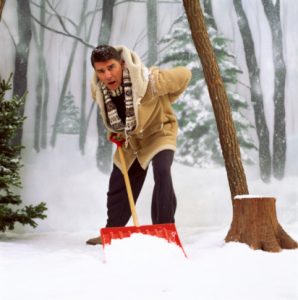
Snow shoveling is a very physical and strenuous activity. If done incorrectly, it can lead to injuries and back pain. Common snow shoveling injuries include overworking of the muscles, falling, hitting yourself with the shovel, straining muscles and ligaments, breaking bones, and experiencing heart- problems. (In fact, seven percent of snow shoveling injuries are heart related.)
Below you will find some helpful tips to reduce your risk of injury while shoveling snow and to prevent back pain.
Tips to avoid back pain
Snow shoveling can be a pain – literally – if not done properly. Orthopedic surgeon Dr. Joseph Abboud said, “Individuals tend to haste through snow shoveling to avoid being outside in the cold for long periods of time. Unfortunately, rushing through this task can lead to injuries. It should always be done at a slow and steady pace because of the energy and focus that’s required. Always check with your doctor before shoveling snow and consider hiring someone to do it for you if you’re unable to.”
In 2014, over 203,000 Americans were treated for injuries related to shoveling snow the old-fashioned way, and over 27,000 were treated for injuries related to snow blowers or snow throwers.
The good news is, experts have shared some useful tips to prevent injuries associated with snow removal. For starters, they advise pushing the snow instead of trying to lift it. If you must lift it, do so with your legs and don’t bend at the waist. Don’t throw snow over your shoulder or off to the side – instead walk to where you’re piling up the snow.
When out shovelling the snow, don’t forget to take breaks. Stay hydrated and if you experience any signs of injury or illness, such as shortness of breath or chest pains, stop what you’re doing and seek medical attention.
Other things to keep in mind include using the right snow shovel, warming up thoroughly, using ergonomic lifting techniques, pacing yourself, and keeping your feet on the group. If shovelling is too difficult you may consider using a snow blower, but there are safety precautions associated with these devices, too.
Even if you’re using a snow blower, you should still proceed with caution. Always read the instructions and never leave it running when you step away. If it gets jammed, try shutting it off for a bit and then restart – never try to clear a jam while it’s running.
Tips to prevent back pain while shoveling snow
- Make sure you have the right gear: Ensuring you have a shovel that is the right length for you will allow you to shovel snow more comfortably, reducing the stress put on your joints. Additionally, using a shovel that is not too heavy, preferably one made of plastic, enables you to shovel snow longer before getting tired. There are also ergonomically shaped shovels, with a bent handle, that are easier on the back.
The gear you’re wearing is also very important, as staying warm makes a big difference when out in the cold weather. It is recommended to wear several layers. Additionally, it is recommended to wear snow boots with grip.
- Push the snow aside whenever possible: It is never a good idea to let snow pile up over time. Instead, push the show when moderate amounts have already accumulated. This will help prevent strain on the back from excessive lifting if you wait too long.
- Use proper lifting technique: It is best to perform a squatting stance when lifting snow and to avoid bending at the waist. This can be achieved by bending your knees, keeping your feet apart, and making sure your back is straight. It is also advised to not pick up an amount of snow that is too much for you to handle comfortably.
- Start early, and take breaks often: While it may make sense to begin shoveling once the snow has finished accumulating, this will make it harder. Instead, choose to make multiple shorter shoveling trips and not rushing to complete it all at once. Take small breaks of 15 minutes if you begin to feel tired.
How to overcome pains after shoveling
- Epsom salt: Soaking your muscles and joints in a mixture of Epson salts and water can help relax the area, providing soothing relief from pain and inflammation. You can also add it to a steaming hot bath for a full body relaxation.
- Rest: Constantly putting stress on your joints will make it difficult to recover. Not taking the time to rest will worsen gouty pain. Elevating the leg can also help relieve pressure on your ankle joint and return blood to the upper part of the body.
- Ice: Simply apply ice to the affected joint to help reduce pain and swelling. Using an ice pack is ideal, but ice cubes in a towel or a bag of frozen vegetables will also do the trick. It is recommended to ice the affected part of the body for about 15 to 20 minutes every two to four hours. Compressing or wrapping the area will help to further reduce swelling.
- Active recovery: While you may want to focus on resting, by performing small, gentle workouts designed to increase blood circulation, you can reduce recovery times. Exercises like foam rolling sessions can help massage the muscles and soothe stiffness.
- Eat well: Eating a healthy and well-balanced diet should be at the top of everyone’s priority list. Eating large amounts of protein will also help during the activity and recovery phases of strenuous exercise.
Follow the above tips when clearing the snow in order to prevent injury. Have a safe winter!
Related: Reduce back pain easily with posture changes